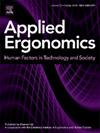对儿童面部形状进行定量分析,为呼吸器设计提供支持。
IF 3.1
2区 工程技术
Q2 ENGINEERING, INDUSTRIAL
引用次数: 0
摘要
COVID-19 大流行表明,需要针对空气传播的病原体提供呼吸保护。适用于儿童的呼吸器非常有限,而且现有的设计没有考虑到面部形状或大小的差异。我们创建了一个来自三个队列的儿童面部图像数据集,然后使用密集和稀疏面部地标表示的几何形态计量分析来量化与年龄、性别和祖先有关的形状差异。我们发现,从 2 岁到 18 岁,儿童的面部形状和大小随着年龄的增长而显著变化,尤其是在与呼吸器设计相关的维度上。在样本的大部分年龄段中,性别差异很小。血统与脸型的显著差异有关,而这些差异可能会影响呼吸器的适配性。我们就如何利用我们的研究结果为儿科人群设计合适的呼吸器等设备提供了指导。我们还强调有必要考虑与祖先有关的面部形态差异,以推广公平、包容的产品。本文章由计算机程序翻译,如有差异,请以英文原文为准。
Quantitative analysis of facial shape in children to support respirator design
The COVID-19 pandemic demonstrated the need for respiratory protection against airborne pathogens. Respirator options for children are limited, and existing designs do not consider differences in facial shape or size. We created a dataset of children's facial images from three cohorts, then used geometric morphometric analyses of dense and sparse facial landmark representations to quantify age, sex and ancestry-related variation in shape. We found facial shape and size in children vary significantly with age from ages 2 to 18, particularly in dimensions relevant to respirator design. Sex differences are small throughout most of the age range of our sample. Ancestry is associated with significant facial shape variation in dimensions that may affect respirator fit. We offer guidance on how to our results can be used for the appropriate design of devices such as respirators for pediatric populations. We also highlight the need to consider ancestry-related variation in facial morphology to promote equitable, inclusive products.
求助全文
通过发布文献求助,成功后即可免费获取论文全文。
去求助
来源期刊

Applied Ergonomics
工程技术-工程:工业
CiteScore
7.50
自引率
9.40%
发文量
248
审稿时长
53 days
期刊介绍:
Applied Ergonomics is aimed at ergonomists and all those interested in applying ergonomics/human factors in the design, planning and management of technical and social systems at work or leisure. Readership is truly international with subscribers in over 50 countries. Professionals for whom Applied Ergonomics is of interest include: ergonomists, designers, industrial engineers, health and safety specialists, systems engineers, design engineers, organizational psychologists, occupational health specialists and human-computer interaction specialists.
 求助内容:
求助内容: 应助结果提醒方式:
应助结果提醒方式:


